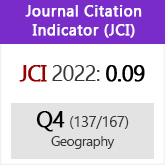The demographic foundation of sociocultural systems
DOI:
https://doi.org/10.3989/estgeogr.201216Keywords:
Sociocultural, Demographic system, Demographic transition, Malthusianism, Social carrying capacity, Demographic deficitAbstract
In Social and Cultural Geography, understood as the «study of the relationship between humans and their environment» and as «science of human settlers», demographic systems are the foundation of sociocultural systems. Demographic systems are built at the expense of the population that lives, so unevenly spread out, on the surface of the earth at any given time and whose components live together and group in order to satisfy their needs. Humanity as a whole is differentiated by the number of individuals that make up the different groups, their characteristics and the dynamics of the processes of internal growth. These factors allow one to differentiate the different demographic systems using a scale of magnitudes in relation to the number of individuals they contain, the nature of their needs and their territorial sphere of influence. Among other things, their effectiveness and stability depend on the sociocultural level of the members of the group. When the effectiveness of a demographic system diminishes, it enters a stage of degradation which concludes in the explicit manifestation of the deficit. The demographic foundation of sociocultural systems is made up of microsystems whose stability usually depends on the living conditions of the population.
Downloads
References
Brentano, L. J. (1910): "The Doctrine of Malthus and the Increase of Population During the Last Decades". Economic Journal, 20/79, pp. 371-93. http://dx.doi.org/10.2307/2221030
Casas Torres, J. M. (1982): Población, desarrollo y calidad de vida. Madrid, Rialp, 491 pp.
Coale, A. J. y Hoover, E. M. (1958): Population Growth and Economic Development in Low Income Countries. Princeton, Nueva Jersey, Princeton University Press, 389 pp.
Coontz, Sidney H. (1957): Teorías de la población y su interpretación económica. México, Fondo de Cultura Económica, 200 pp.
Castro, J. de (1961). Geografía del hambre. Santiago de Chile, Editorial universitaria, 240 pp.
Demangeon, A. (1942): Problèmes de Géographie Humaine. Paris, Armand Colin, 408 pp.
Demeny, P. et al. (2003): Encyclopedia of Population. Washington, MacMillan, Revised Edition.
Derruau, M. (1961): Prècis de Gèographie Humaine. Paris, Librairie Armand Colin, 575 pp.
Doubleday (1841): The true law of population shewn to be connected with the Food of the People. London, Routledge, 203 pp.
Dumont, A. (1890): Depopulation et civilisation. Étude démographique. Paris, Lecrosnier et Babé, 532 pp.
Ehrlich, P. y Ehrlich, A. (1970-1972): Population, Resources, Environment. Issues in Human Ecology. San Francisco, W. H. Freeman and Co, 523 pp.
George, P. (1951): Introduction a l Étude Géographique de la Population du Monde. Travaux et Documents, Cahier 14, Paris, I.N.E.D.-P.U.F., 284 pp.
Higueras Arnal, A. (1992): La población mundial hacia el Tercer Milenio. Zaragoza, Universidad de Zaragoza, 34 pp.
Johnston, R. J. et al. (eds.) (1988): Dictionary of Human Geography. Oxford, Blackwell Publishers.
Keynes, J. M. (1970): Primer ensayo sobre la población: Robert Malthus (1766-1834). Madrid, Alianza Editoral, 318 pp.
Landry, A. (1934): La revolution démographique. Paris, Sirey, 127 pp.
Le Lannou, M. (1949): La Géographie Humaine. Paris, Flammarion éditeur, 254 pp.
Noin, D. (1997): “L’ Humanité sur la planète. Carte mondiale E.: 1/15.000.000”, en UNESCO (ed.): Atlas et cartes scientifiques. Paris, Èditions UNESCO, 46 pp. Organización Mundial de la Salud (2012): Informe 2012 OMS/UNICEF: progresos sobre el agua potable y saneamiento. Estadísticas sanitarias mundiales 2011. OMT, 178 pp.
Population Reference Bureau (2012): World Population Data Sheet. Washington. Disponible en: www.prb.org (Fecha de consulta: 15/08/2012).
Ratzel, F. (1891): Antropogeografía. Stuttgart, 606 pp.
Rowe, J. W. y Kahn, I. R. (1997): "Successful Aging". The Gerontologist, 37/4, pp. 433-440. http://dx.doi.org/10.1093/geront/37.4.433 PMid:9279031
Sauvy, A. (1954): Theorie génerale de la population. Paris, PUF, 2 vols.
Sorre, M. (1943-1952): Les fondaments de la géographie humaine. Paris, Armand Colin, 3 vols. (440, 1031, 440).
Thompson, W. S. (1929): "Population". American Sociological Review, 34/6, pp. 959-975. http://dx.doi.org/10.1086/214874
Vallois, H. V. (1952): Les hommes fossiles. Eléments de paléontologie humaine. Paris, Masson, 492 pp.
Verhulst, P. Fr. (1838): Notice sur le loi que la population porsuit dans son acroissement. Bruselas, Corresp. Maths. Phis., 10, pp. 113-121.
Vidal de la Blache, P. (1955): Principes de Géograhie Humaine. Reimpresión de la edición póstuma publicada en 1921. Paris, Librairie Armand Colin, 327 pp.
Downloads
Published
How to Cite
Issue
Section
License
Copyright (c) 2012 Consejo Superior de Investigaciones Científicas (CSIC)

This work is licensed under a Creative Commons Attribution 4.0 International License.
© CSIC. Manuscripts published in both the printed and online versions of this Journal are the property of Consejo Superior de Investigaciones Científicas, and quoting this source is a requirement for any partial or full reproduction.All contents of this electronic edition, except where otherwise noted, are distributed under a “Creative Commons Attribution 4.0 International” (CC BY 4.0) License. You may read here the basic information and the legal text of the license. The indication of the CC BY 4.0 License must be expressly stated in this way when necessary.
Self-archiving in repositories, personal webpages or similar, of any version other than the published by the Editor, is not allowed.
















